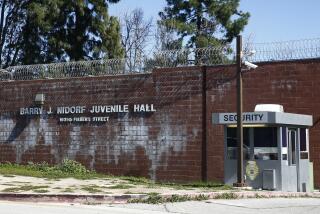Editorial: Is L.A.’s new juvenile jail really worth $48 million? Yes. Here’s why
Los Angeles County’s impressive Campus Kilpatrick opens its doors Friday and will welcome its first juvenile residents next month, and that is cause for cautious optimism and careful stock-taking in the county’s troubled Probation Department.
Discussion of the facility first requires some frank definitions, though, because there are no euphemisms more strained or misleading than those that describe the juvenile justice system. Let’s make it clear before going further: Although it’s tucked away in a picturesque corner of the Malibu Hills, has a pool, basketball courts and a library, and will have daily activities, Campus Kilpatrick is a locked facility for people younger than 18 found to have committed crimes. It’s a juvenile probation camp, a jail for kids.
L.A. County has three juvenile halls, where minors go when they have been accused of but not yet convicted of criminal offenses. Including Campus Kilpatrick, the county has 19 “camps” — not day camps or summer camps, but institutions that hold preteens, teenagers and sometimes young adults who have been found guilty (although that’s not a term used in the juvenile justice system).
The old Kilpatrick was razed and replaced by a facility that does indeed look and feel more like — well, if not a camp, perhaps a small college campus.
Despite their idyllic locations, probation camps often are miserable places. Many were built during a 1990s panic over juvenile crime, when politicians successfully campaigned on claims that the nation was beset by a wild and uncontrollable generation of vicious young predators who had to be apprehended and severely punished — although California law permits juvenile offenders to be held only for rehabilitation, not retribution. In L.A. County, officers were disciplined over the years for staging gladiator-type fights among inmates, for beating them and even for having sex with them.
Meanwhile, some deeper thinking and solid studies on juvenile justice suggested that judges could do a far better job at distinguishing the few more difficult offenders from those who could be successfully — and safely — supervised and rehabilitated without being locked away. As the new thinking took hold in the last decade and camp populations plummeted, so did juvenile crime. Community supervision worked — for most.
But there remain offenders who require more intensive supervision, often in the form of therapy that helps them cope with the chaos and trauma they have experienced in their young lives. The large, gray, prison-like barracks of old-style probation camps are inadequate for that level of rehabilitation.
That’s where Campus Kilpatrick comes in. At $48 million, it was a breathtakingly costly project. But with the help of state bond money, the old Kilpatrick was razed and replaced by a facility that does indeed look and feel more like — well, if not a camp, perhaps a small college campus, notwithstanding the locked gates. Living quarters resemble those in more modern private group homes, four or six beds to a unit. The staff-to-ward ratio is smaller. Probation officers, psychologists and other staff who requested assignment to the new Kilpatrick have been intensively trained in what county leaders like to call “the L.A. model” of juvenile rehabilitation. It is based in part on a Missouri program that features small groups and positive reinforcement, and that — significantly — boasts remarkably low rates of new offenses following release.
Juvenile justice has weathered numerous trends over the years. There was a time, not long ago, when county supervisors demanded that probation camps be military-style boot camps because they just knew, in their core, that young offenders needed discipline. But those programs simply produced offenders who would stand straight and say “sir” to judges after being caught committing new crimes. Others just knew, in their core, that offenders needed art, or dance — or a few months in the Malibu Hills — to change their behavior. In its previous incarnation, Camp Kilpatrick was famous for its sports program, which was featured in the 2006 movie “The Gridiron Gang,” and some probation officers remain bitter at the dismantling of the program along with the old camp.
But what politicians or self-described experts claim to “know” in their core about rehabilitation means nothing without actual evidence of low criminal recidivism and high achievement in life over a period of years, as has been the experience in Missouri. The new Campus Kilpatrick (“Campus” being a better description of the new facility than “Camp,” or perhaps just another euphemism) will be a success only if numbers bear out the optimism that has been building over the years as successes have been recorded in Missouri and other jurisdictions.
That’s the difference — the measurable positive results — between the Kilpatrick approach and all the earlier trends and fashions in juvenile justice. The L.A. Model will be valid if — and only if — the results remain measurable and positive.
Follow the Opinion section on Twitter @latimesopinion and Facebook
More to Read
A cure for the common opinion
Get thought-provoking perspectives with our weekly newsletter.
You may occasionally receive promotional content from the Los Angeles Times.










